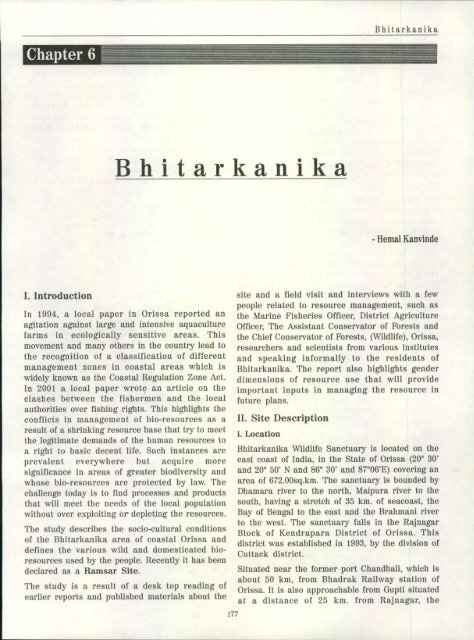06-bioresourcesstatu.. - M. S. Swaminathan Research Foundation
06-bioresourcesstatu.. - M. S. Swaminathan Research Foundation
06-bioresourcesstatu.. - M. S. Swaminathan Research Foundation
You also want an ePaper? Increase the reach of your titles
YUMPU automatically turns print PDFs into web optimized ePapers that Google loves.
I. Introduction<br />
Bhitarkanika<br />
In 1994, a local paper in Orissa reported an<br />
agitation against large and intensive aquaculture<br />
farms in ecologically sensitive areas. This<br />
movement and many others in the country lead to<br />
the recognition of a classification of different<br />
management zones in coastal areas which is<br />
widely known as the Coastal Regulation Zone Act.<br />
In 2001 a local paper wrotE1 an article on the<br />
clashes between the fishermen and the local<br />
authorities over fishing rights. This highlights the<br />
conflicts in management of bio-resources as a<br />
result of a shrinking resource base that try to meet<br />
the legitimate demands of the human resources to<br />
a right to basic decent life. Such instances are<br />
prevalent everywhere but acquire more<br />
significance in areas of greater biodiversity and<br />
whose bio-resource~ are protected by law. The<br />
challenge today is to find processes and products<br />
that will meet the needs of the local population<br />
without over exploiting or depleting the resources.<br />
The study describes the socio-cultural conditions<br />
of the Bhitarkanika area of coastal Orissa and<br />
defines the various wild and domesticated bioresources<br />
used by the people. Recently it has been<br />
declared as a Ramsar Site.<br />
The study is a result of a desk top reading of<br />
earlier reports and published materials about the<br />
177<br />
Bhitarkanika<br />
- Hemal Kanvinde<br />
site and a field visit and interviews with a few<br />
people related to resource management, such as<br />
the Marine Fisheries Officer, District Agriculture<br />
Officer, The Assistant Conservator of Forests and<br />
the Chief Conservator of Forests, (Wildlife), Orissa,<br />
researchers and scientists from various institutes<br />
and speaking informally to the residents of<br />
Bhitarkanika. The report also highlights gender<br />
dimensions of resource use that will provide<br />
important inputs in managing the resource in<br />
future plans.<br />
II. Site Description<br />
i. Location<br />
Bhitarkanika Wildlife Sanctuary is located on the<br />
east coast of India, in the State of Orissa (20° 30'<br />
and 20° 50' Nand 86° 30' and 87°<strong>06</strong>'E) covering an<br />
area of 672.00sq.km. The sanctuary is bounded by<br />
Dhamara river to the north, Maipura river to the<br />
south, having a stretch of 35 km. of seacoast, the<br />
Bay of Bengal to the east and the Brahmani river<br />
to the west. The sanctuary falls in the Rajnagar<br />
Block of Kendrapara District of Orissa. This<br />
district was established in 1993, by the division of<br />
Cuttack district.<br />
Situated near the former port Chandbali, which is<br />
about 50 km, from Bhadrak Railway station of<br />
Orissa. It is also approachable from Gupti situated<br />
at a distance of' 25 km. from Rajnagar, the










